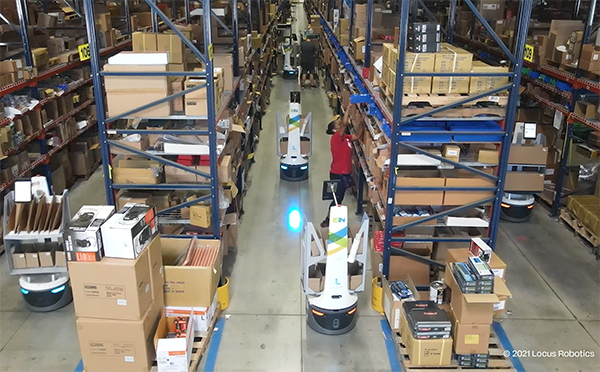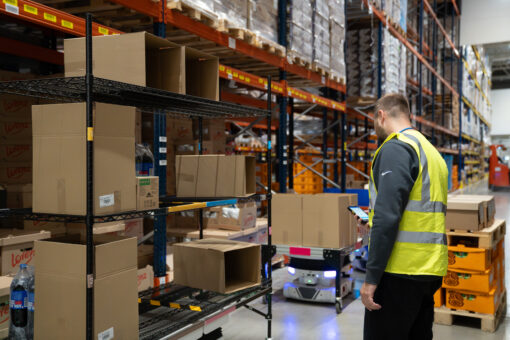WP: How to achieve 400 UPH with Locus Fast Pick
WP: How to achieve 400 UPH with Locus Fast Pick Download Now!
How Robots Improve the Safety and Well-Being of Warehouse Workers
Abner Rojas, Customer Success Specialist of Robotics at Körber Supply Chain

From a business perspective, we often hear about all the benefits robotics bring to the table and how they are flexible and scalable, helping to increase companies’ KPIs, and assisting in overcoming several labor-related issues. All of these are true and important, but what about the positive physical impact that robotics has on human workers?
The work and environment in a warehouse can be difficult. Many warehouses have their associates walking more than 13 miles in one shift and other warehouses have associates who are standing up to 10 hours a day packing orders. An article in Forbes, “Warehouse Labor Woes Are Worse Than Ever,” referenced an Occupational Safety and Health Administration (OSHA) study that showed that the number of warehouse workers’ injuries has continually increased in the past several years. How can robotics help alleviate these injuries and keep your workers safe, while getting your orders out on time?
Reducing Physical Strain
In the supply chain industry, I often walk through warehouses thinking about robotic solutions that could deliver meaningful improvement to an operation. More importantly, I think about how these robotic solutions support and add value to the most important asset of the warehouse, which is the warehouse worker.
Robotics in the warehouse can help alleviate the physical strain and reduce the risk of repetitive stress injuries for human workers. Certain tasks like heavy lifting, carrying, or moving large items can all be automated with the help of robots. This minimizes the risk of physical injuries and allows the workers to focus on more skilled and cognitive tasks, leading to improved overall health, well-being, and often times job satisfaction.
Enhancing Workplace Safety
With the introduction of robotics, warehouses can experience improved workplace safety conditions. Robots are designed to follow strict safety protocols that help prevent workplace accidents and injuries. They are also equipped with sensors and advanced algorithms to detect and avoid collisions with human workers, creating a safer environment in the warehouse. Furthermore, accidents in the warehouse are typically due to human error, while machines are built to operate in a safe manner, even in a collaborative environment.
An article by the Centers for Disease Control and Prevention (CDC) titled “Robotics and Workplace Safety” explains that robots have existed in the workplace for years, but their presence on job sites is increasing, as well as their capabilities. Industrial robots are no longer confined to cages or cells. Today’s robots are designed to work alongside, move amongst, and be worn by human workers. Additionally, robots can perform tasks in hazardous areas or handle dangerous materials, reducing the exposure of human workers to those potential risks.
Increasing Productivity and Efficiency
Along with the safety benefits, robotics increase productivity and efficiency for warehouse workers by automating material handling tasks, improving inventory management, and streamlining order fulfillment. These robotic solutions free up the workers’ time, reduce manual tasks, and enhance overall operational effectiveness in the warehouse environment.
In some cases, robotics can work collaboratively with human workers to increase productivity. This collaboration between robots and humans maximizes efficiency by leveraging the strength of both. In fact, Integrated Supply Network (ISN) found that deploying autonomous mobile robots (AMRs) into their warehouse resulted in a 266% improvement in productivity. The company then leveraged a portion of the savings to increase employee wages, which resulted in improved working conditions for the associates as well as addressing the key problem they were looking to solve by reducing turnover in the facility.
The proliferation and mass availability of robots for warehouse operations has resulted in a need for operations to execute diligence when considering a robotic solution to improve their operations. One way to do this is to establish supply chain partnerships with leaders in the field that have the ability to provide guidance in a crowded market.
In conclusion, robotics has emerged as a powerful tool that empowers human workers and changes the way they operate within the warehouse. By reducing physical strain, robots enable humans to focus on tasks that require their unique skills, creativity, and problem-solving abilities. Moreover, robots enhance workplace safety for human workers by the robots taking on dangerous and repetitive tasks, minimizing the risk of workplace accidents and injuries.
Additionally, robotics contribute to increased productivity and efficiency within the warehouse by reducing errors and optimizing workflows. It's important to continue to embrace the collaboration between humans and robots in order to support a future where human workers are empowered to reach new heights and unlock new opportunities for growth. Ultimately, this will lead to shaping a world where technology empowers the human worker to do more with less in the workplace.
About the Author
Abner Rojas is the Customer Success Specialist of Robotics at Körber Supply Chain. In this role, Rojas is responsible for executing additional awareness of autonomous mobile robots and serves as a trusted advisor to drive knowledge and additional opportunities for Körber’s robotics portfolio. Prior to joining Körber, Rojas worked as a Partner Alliance Specialist at Locus Robotics where he managed and developed strategic partnerships and established robotics as a preferred solution across all product and service lines. With over a decade of sales experience and building strong relationships, Rojas is committed to continuing to share his passion and knowledge surrounding all things robotics in the supply chain.




